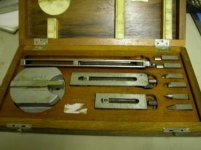MJBOLSTER
Plastic
- Joined
- Jun 19, 2008
- Location
- USA, So. Maryland
.... in a precision vice for an open set up inspection routine?
I know that calibration labs don't even want us to breath around precision gages, jo blocks being one type. But, as a practical matter, is it bad practice for a screening inspection lab to put a stack of blocks between the jaws of a "precision" vice (with ground faces, etc.) in order to use the jaws as say a go or no-go gage? I think about the weight of a fairly large sine plate on a block (distributed on a line basically) as being more risky to the structure of the block than between precise vice jaws. The only pressure necessary would be to keep the blocks in position. I can imagine many variables and the preference of using an adjustable parallel or something else instead of precision blocks. And, it may depend on who owns the blocks.....
......but what do y'all think.....practically speaking??
MJB
I know that calibration labs don't even want us to breath around precision gages, jo blocks being one type. But, as a practical matter, is it bad practice for a screening inspection lab to put a stack of blocks between the jaws of a "precision" vice (with ground faces, etc.) in order to use the jaws as say a go or no-go gage? I think about the weight of a fairly large sine plate on a block (distributed on a line basically) as being more risky to the structure of the block than between precise vice jaws. The only pressure necessary would be to keep the blocks in position. I can imagine many variables and the preference of using an adjustable parallel or something else instead of precision blocks. And, it may depend on who owns the blocks.....
......but what do y'all think.....practically speaking??
MJB


